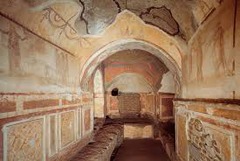
*Title:* Catacomb of Priscilla
*Artist:*
*Period/Style:* Late Antique / Early Christian
*Date:* 200-400 CE
*Patron:*
*Original Location:* Rome
*Material:* volcanic rock
*Subject:* contains Greek Chapel (place for family to put sarcophagi and also have meals as part of a memorial to the dead)
-Fresco of Breaking of the Bread and Fish
-Abraham's Sacrifice of Isaac
-Jonah and the Whale
-Woman and Child
*Technique and Description:*
-excavated/subtractive structure
-fresco (1st style)
-prefiguration
-lunetts
-medallion
-abstraction (no individuality, no background to indicate space)
-natrualistic (shadow and shading)
-funerary and didactic functions
*Context:*
-Priscilla was wealthy, martyred, left estate to Christian church so they built catacombs
-Virgin Mary impregnated by God's words and gives birth to baby Jesus
-Jesus grows up and sees unhappiness in his people (the Jews) b/c they were treated as 2nd class citizens
-Jesus becomes a prophet (thought he was improving his religion)
-Christians believe in a rewarding afterlife and a loving God
-spoke to the weak and persecuted, so appealing
-similar to Mystery Religions
-Christianity becomes unifying force for Romans
-Judas betrays Jesus, Last Supper, Crucifixion, Descent, Lamentation, Resurrection, Ascension
-return of Christ seemed imminent to Christian followers, but he doesn't show up right away so Christians must deal w/ this disappointment
-Christians anger Romans b/c citizens in empire expected to give physical offerings to divine king (Jews exempt) but Christians refuse to pay tax (treason)
-not all Romans didn't want to kill Christians, but Christians wanted to by marry b/c believe in Heaven and would die like Jesus
*Message/Meaning:*
-not for praying, but
-*Abraham's Sacrifice of Isaac*: Abraham is a prefiguration of God and Isaac is a prefiguration of Jesus in story where Abraham is about to sacrifice his son
-*Jonah and the Whale*: Jonah is a prefiguration of Jesus when he was eaten by a whale and emerged 3 days later
-the *Woman and Child* fresco may depict Mary and Jesus because Mary gives birth in a barn and a bright star emerges in the sky (the fresco also features a star)
-dove in lunette: symbol of peace (seen in Noah's Ark story and Greek tradition) and also represents the Holy Spirit
-peacock in lunette: symbol of Jesus' immortal body and of Christian soul receiving salvation (b/c believed peacocks' bodies did not rot after death)
*Title:* Orant Fresco
*Artist:*
*Period/Style:* Late Antique / Early Christian
*Date:* 200-400 CE
*Patron:*
*Original Location:* Greek Chapel, Catacomb of Priscilla, Rome
*Material:* paint on volcanic rock
*Subject:* woman seen 3 times
left: marriage
right: motherhood
center: dead in spirit form (faces God and asks for salvation)
*Technique and Description:*
-fresco
-continues narrative
-naturalistic (shadows/shading)
-funerary function
*Context:*
-"orator" women speaking to God
-Christians believed in rewarding afterlife and kind God
*Message/Meaning:*
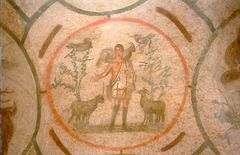
*Title:* Good Shepherd Medallion
*Artist:*
*Period/Style:* Late Antique / Early Christian
*Date:* 200-400 CE
*Patron:*
*Original Location:* Orant Fresco, Greek Chapel, Catacomb of Priscilla, Rome
*Material:* paint on volcanic rock
*Subject:* male sheep (rams) but no horns b/c baby rams and don't want to mistake them for goats (goats are bad)
*Technique and Description:*
-fresco
-medallion
-lunettes (surrounding medallion)
-funerary and didactic functions
*Context:*
-surrounded by lunettes
-According to St. Paul, God sacrificed Jesus to erase the original sin started with Adam and Eve's actions
-Early Christian art looks very Roman (evidence of syncretism/appropriation in art; also likely bc Jews didn't make art to mimic so turned to secular inspirations), was somewhat private (open to Christians but hidden b/c perfection), combination of naturalism and abstraction, had funerary and didactic functions
-start breaking 2nd Commandment b/c a lot of people illiterate
*Message/Meaning:*
-Jesus = "the lamb of god" (lamb is highest sacrifice); lamb also symbol of Christian souls
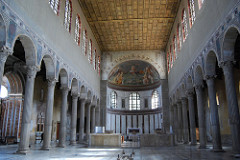
*Title:* Basilica of Santa Sabina
*Artist:* Peter of Illyria, a Dalmatian priest
*Period/Style:* Early Christian
*Date:* 422-432 CE
*Patron:*
*Original Location:* Rome, Italy
*Material:* brick, stone, wooden roof
*Subject:* early Christian Church
*Technique and Description:*
-axial plan
-aisles
-apse
-axis mundi
-spolia (Corinthian columns)
-nave
-clerestory
-propaganda
*Context:*
-oldest church still existing in Rome
-dedicated to martyr Sabina
-built on site of Juno's Temple
-space in apse exclusive for Church hierarchy
-313 Edict of Milan: Constantine legalizes Christianity (mother converted and he saw cross in a dream before winning a battle --> so he adopts religion too, introduces Christianity to violence)
-end of 4th cent. Christians begin persecuting non Christians; Christianity is Roman Empire's official religion; Christian hierarchy established
*Message/Meaning:*
-early church divided the sexes (in different aisles)
-processional: incense --> creates holy atmosphere and beautiful robes and jewelry --> make it a glorified space, things last forever like stone and metal
-outside is simple, heavy --> metaphor for human body and soul where exterior is plan and interior is dazzling
-built on site of Juno's Temple, kept Corinthian columns --> projected power (Christian vs. Pagan)
-3 windows in apse references Holy Trinity
-wood carvings on door depict Old and New Testament stories --> Christians comfortable with breaking 2nd commandment to tell stories
-controlled light b/c it represents God
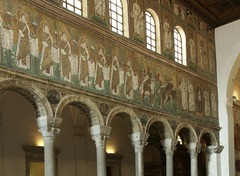
*Title:* Basilica of Sant'apollinare Nuovo
*Artist:*
*Period/Style:* Byzantine
*Date:* 526 CE
*Patron:*
*Original Location:* Ravenna, Italy
*Material:*
*Subject:* Church featuring murals depicting procession and emporeror
*Technique and Description:*
-mosaic (with shading)
-axial plan
*Context:*
-Christianity asserts itself as a powerful religion and associates with Byzantine power structure
-inspired by Roman art but make new styles
-priests continue preaching humility while dressed as emperors (hypocritical)
-visualize Jesus as emperor, Lord in Heaven and a lord on earth
-Byzantine steps into Roman Empire which dissolves in west and changes in east (keep power structure)
-try to preach in a way that kept lower class from questioning authority
-Byzantine emperor makes himself head of church (funds art)
-religious art becomes an act of anonymous devotion, took very seriously b/c people took notes on mistakes and it influenced afterlife
-symbolism becomes more important than realism (naturalism can distract form meaning)
*Message/Meaning:*
MOSAIC:
-Jesus dressed like an emperor, enthroned, feet don't touch the floor, bearded (wiser)
-holding candle to signify Holy Spirit
-ground implies heavenly garden, gold background is heavenly/timeless/spiritual
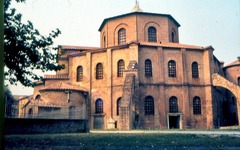
*Title:* San Vitale
*Artist:*
*Period/Style:* Byzantine
*Date:* 526 CE
*Patron:* Bishop Ecclesius and Archbishop Maximian (Money from Justinian and Theodora)
*Original Location:* Ravenna, Italy
*Material:* gold and precious stones used in mosaics
*Subject:* Structure taken from Germanic Tribes by Justinian and converted into Church with several murals
*Technique and Description:*
-Basilica
-central plan
-octagonal plan
-aisle
-nave
-apse
-narthex
-flying buttresses
-squinches
-columns use abstracted and geometric vegetative capitals (entirely new style, no spolia)
-mosaics (symbolic)
*Context:*
-Christianity asserts itself as a powerful religion and associates with Byzantine power structure
-Byzantine steps into Roman Empire which dissolves in west and changes in east (keep power structure)
-Constantinople thrives in east, Rome sacked by Germanic thrives in the weest
-Byzantine emperors want to take back Roman Empire
-Justinian takes back Ravenna, Italy in most successful escapade, Germanic tribes converted
-Theodora (Justinian's wife, actress maybe prostitute) influenced Justinian to help poor, women, orphans; scandalous, people blamed her for everything
*Message/Meaning:*
-central/ octagonal floor plan goes on forever, sense of infinity, death and Resurrection)
-narthex marks the sinners while allowing them to pray/ask for forgiveness
-outside plain, interior dazzling
-Jesus seen as lamb, haloed, surrounded by victory wreath
-mosaic w/ continuous narrative of Abraham and Isaac prefiguration (have landscape but not realistic)
-mosaic w/ Jesus giving wreath to martyr and ____ (patron) giving Jesus the San Vitale --> patrons elevate themselves in art
-mosaic w/ Justinian shows him in procession, he has halo (makes himself more holy than archbishops)
-warriors to the left (shield has chi-rho)
-priests to the right (hold cross, dazzling Bible, and censer); dressed in pure white robes to show purity
-Justinian has best shoes, standing on warrior's feet, archbishop may be a bit in front; Justinian holding bread for Communion (bread positions him over arch bishop, but bread really Jesus); Justinian has some scruff to show he's busy taking care of the empire
-mosaic w/ Theodora shows her w/ Chalise for blood fo Christe (traditionally only for men), haloed, standing in apse --> even more holy than Justinian
-curtain reveals fount of holy water, different curtain reveals ladies in waiting (women usually inside, concealed, out of public sight but allowed for processional)
-Theodora's robes have 3 wise men/magi
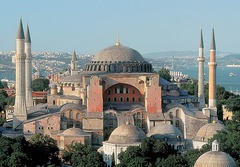
*Title:* Hagia Sophia
*Artist:* Anthemius of Tralles and Isidorus of Miletus
*Period/Style:* Byzantine
*Date:* 530 CE
*Patron:* Justinian I
*Original Location:* Constantinople; modern day Istanbul, Turkey
*Material:* marbles from all over empire
*Subject:* Church, later converted into Mosque, and now a museum
*Technique and Description:*
-central and axial plan
-dome (bottom has 40 windows)
-arches
-half domes
-minarets added
-pendentive
-hidden piers
*Context:*
-Justinian ended a riot in one of his cities, burned citizens, needs to assert power
-Pagan temple --> Christian basilica --> Hagia Sophia
-largest church in the entire world
-down the street from Justinian's palace
-1400's Ottoman Empire takes over, converted to Muslim mosque (cover mosaics w/ silks, add medallions, added minarets)
*Message/Meaning:*
-windows in dome make it look like it is suspended from heaven
-when emperor and archbishop came together, symbolized heavenly and earthly power
-mosaic
-features mosaic with Christ as Pantocrator --> cannot look him in the eyes b/c he is so powerful
*Title:* Virgin and Child Between the Saints
*Artist:*
*Period/Style:* Byzantine
*Date:* 6th or 7th cent. CE
*Patron:*
*Original Location:* Egypt
*Material:* encaustic (hot, colored wax) on wood
*Subject:* icon depicting Virgin and Child between saints (may be Mary and Jesus but not confirmed)
*Technique and Description:*
-icon
-overlapping perspective yet spatial ambiguity
*Context:*
-icons violate 2nd commandment and misdirection of prayer (supposed to focus prayer through figure to God, not worship figure)
-iconoclasm- 8th cent. people destroyed icons
*Message/Meaning:*
-meant to channel prayer through image to God
-angels on top look up at light which shines on Virgin and baby (light is often God)
-spatial ambiguity creates otherworldly feeling
-Virgin does not make eye contact with viewer unlike saints
-gets more holy as you go up on composition, even includes viewer in hierarchy (viewer stands before the scene)
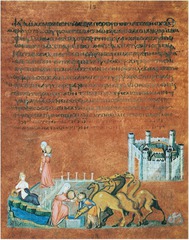
he who struggles with God)
*Technique and Description:*
-continuous narrative
-overlapping perspective
-bad perspective
-poor realism
-shading
*Context:*
-oldest collection of folios and pages (illuminated manuscript)
-Roman influence: shading
-Byzantine influence: poor realism, bad perspective (colonnade and walled city)
-artist caught in period of transition in art style
*Message/Meaning:*
-page dyed purple --> likely belonged to a royal
-naked woman is personification of mouth of the river
-wrapping bridge shows attempt at perspective and helps read narrative
-mouth of river is naked, reclining (Roman)
-Rebecca is modestly dressed (Christian)" alt="*Title:* Vienna Genesis
*Artist:*
*Period/Style:* Byzantine
*Date:* early 6th cent. CE
*Patron:*
*Original Location:* Syria or Constantinople
*Material:* pigment on vellum/ parchment (dyed purple; silver ink)
*Subject:*
-depicts Rebecca and Eliezer at the well (Abraham sends his servant Eliezer to find son Isaac a wife, Eliezer prays and Rebecca shows up)
-Jacob wrestles w/ agnel, gets new name ("Israel" --> he who struggles with God)
*Technique and Description:*
-continuous narrative
-overlapping perspective
-bad perspective
-poor realism
-shading
*Context:*
-oldest collection of folios and pages (illuminated manuscript)
-Roman influence: shading
-Byzantine influence: poor realism, bad perspective (colonnade and walled city)
-artist caught in period of transition in art style
*Message/Meaning:*
-page dyed purple --> likely belonged to a royal
-naked woman is personification of mouth of the river
-wrapping bridge shows attempt at perspective and helps read narrative
-mouth of river is naked, reclining (Roman)
-Rebecca is modestly dressed (Christian)">
*Title:* Vienna Genesis
*Artist:*
*Period/Style:* Byzantine
*Date:* early 6th cent. CE
*Patron:*
*Original Location:* Syria or Constantinople
*Material:* pigment on vellum/ parchment (dyed purple; silver ink)
*Subject:*
-depicts Rebecca and Eliezer at the well (Abraham sends his servant Eliezer to find son Isaac a wife, Eliezer prays and Rebecca shows up)
-Jacob wrestles w/ agnel, gets new name ("Israel" --> he who struggles with God)
*Technique and Description:*
-continuous narrative
-overlapping perspective
-bad perspective
-poor realism
-shading
*Context:*
-oldest collection of folios and pages (illuminated manuscript)
-Roman influence: shading
-Byzantine influence: poor realism, bad perspective (colonnade and walled city)
-artist caught in period of transition in art style
*Message/Meaning:*
-page dyed purple --> likely belonged to a royal
-naked woman is personification of mouth of the river
-wrapping bridge shows attempt at perspective and helps read narrative
-mouth of river is naked, reclining (Roman)
-Rebecca is modestly dressed (Christian)

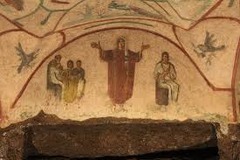





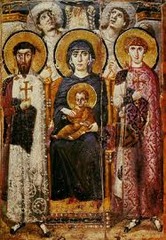
 he who struggles with God)
*Technique and Description:*
-continuous narrative
-overlapping perspective
-bad perspective
-poor realism
-shading
*Context:*
-oldest collection of folios and pages (illuminated manuscript)
-Roman influence: shading
-Byzantine influence: poor realism, bad perspective (colonnade and walled city)
-artist caught in period of transition in art style
*Message/Meaning:*
-page dyed purple --> likely belonged to a royal
-naked woman is personification of mouth of the river
-wrapping bridge shows attempt at perspective and helps read narrative
-mouth of river is naked, reclining (Roman)
-Rebecca is modestly dressed (Christian)" alt="*Title:* Vienna Genesis
*Artist:*
*Period/Style:* Byzantine
*Date:* early 6th cent. CE
*Patron:*
*Original Location:* Syria or Constantinople
*Material:* pigment on vellum/ parchment (dyed purple; silver ink)
*Subject:*
-depicts Rebecca and Eliezer at the well (Abraham sends his servant Eliezer to find son Isaac a wife, Eliezer prays and Rebecca shows up)
-Jacob wrestles w/ agnel, gets new name ("Israel" --> he who struggles with God)
*Technique and Description:*
-continuous narrative
-overlapping perspective
-bad perspective
-poor realism
-shading
*Context:*
-oldest collection of folios and pages (illuminated manuscript)
-Roman influence: shading
-Byzantine influence: poor realism, bad perspective (colonnade and walled city)
-artist caught in period of transition in art style
*Message/Meaning:*
-page dyed purple --> likely belonged to a royal
-naked woman is personification of mouth of the river
-wrapping bridge shows attempt at perspective and helps read narrative
-mouth of river is naked, reclining (Roman)
-Rebecca is modestly dressed (Christian)">
he who struggles with God)
*Technique and Description:*
-continuous narrative
-overlapping perspective
-bad perspective
-poor realism
-shading
*Context:*
-oldest collection of folios and pages (illuminated manuscript)
-Roman influence: shading
-Byzantine influence: poor realism, bad perspective (colonnade and walled city)
-artist caught in period of transition in art style
*Message/Meaning:*
-page dyed purple --> likely belonged to a royal
-naked woman is personification of mouth of the river
-wrapping bridge shows attempt at perspective and helps read narrative
-mouth of river is naked, reclining (Roman)
-Rebecca is modestly dressed (Christian)" alt="*Title:* Vienna Genesis
*Artist:*
*Period/Style:* Byzantine
*Date:* early 6th cent. CE
*Patron:*
*Original Location:* Syria or Constantinople
*Material:* pigment on vellum/ parchment (dyed purple; silver ink)
*Subject:*
-depicts Rebecca and Eliezer at the well (Abraham sends his servant Eliezer to find son Isaac a wife, Eliezer prays and Rebecca shows up)
-Jacob wrestles w/ agnel, gets new name ("Israel" --> he who struggles with God)
*Technique and Description:*
-continuous narrative
-overlapping perspective
-bad perspective
-poor realism
-shading
*Context:*
-oldest collection of folios and pages (illuminated manuscript)
-Roman influence: shading
-Byzantine influence: poor realism, bad perspective (colonnade and walled city)
-artist caught in period of transition in art style
*Message/Meaning:*
-page dyed purple --> likely belonged to a royal
-naked woman is personification of mouth of the river
-wrapping bridge shows attempt at perspective and helps read narrative
-mouth of river is naked, reclining (Roman)
-Rebecca is modestly dressed (Christian)">